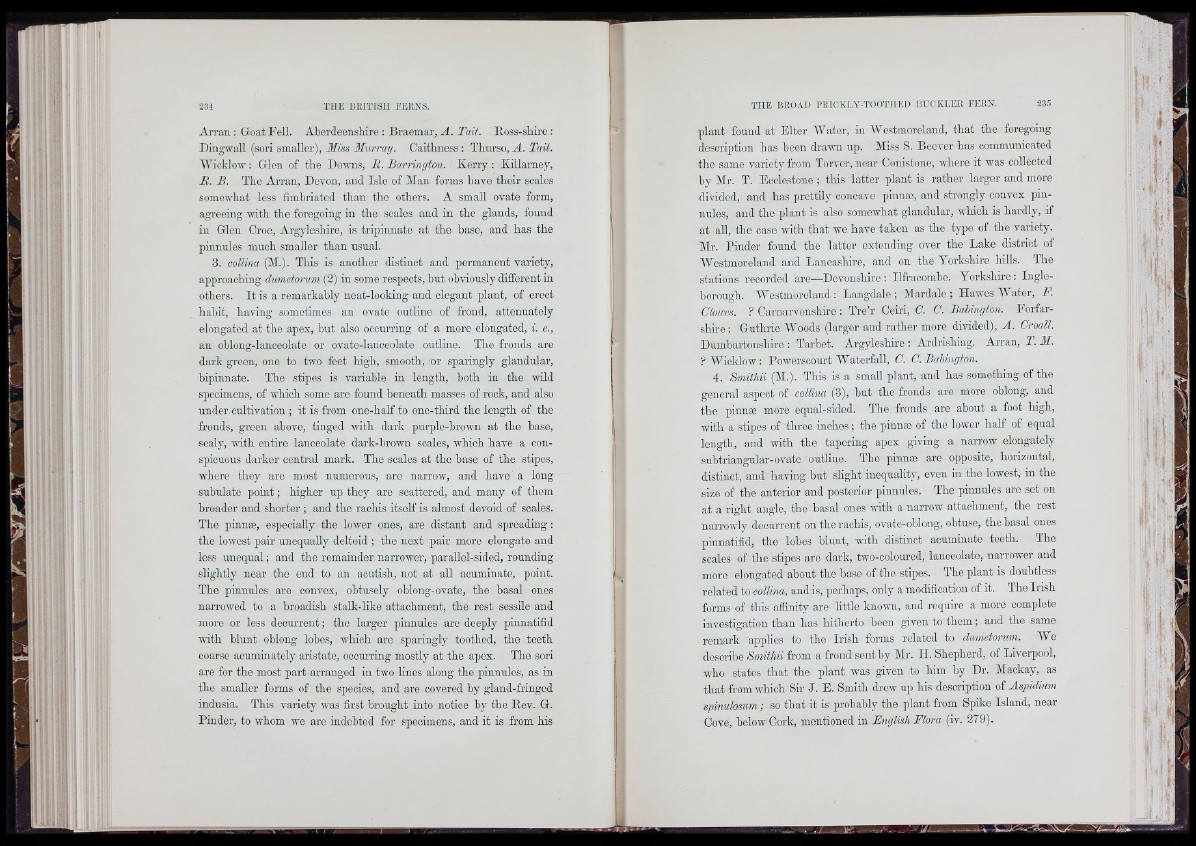
t
m
< !
An-an: Goat Fell. Aberdeenshire: Braemar, A. Tait. Eoss-shire:
Dingwall (sori smaller). Miss Murray. Caithness : Thurso, A. Tait.
Wicklow : Glon of the Downs, R. Barrington. Kerry : Killarney,
R . B. Tho Arran, Devon, and Isle of Man forms have their scales
somewhat less fimbriated than the others. A small ovate form,
agreeing with the foregoing in the scales and in the glands, found
iu Glen Croe, Argyleshire, is tripinnate at the base, and has the
pinnules much smaller than usual.
3. collina (M.). This is another distinct and permanent variety,
approaching dumetorum (2) in some respects, but obviously different in
others. I t is a remai’kably noat-lookiiig and elegant plant, of erect
hahit, having sometimes an ovate outline of frond, attenuately
elongated at tho apox, hut also ocourring of a more elongated, i. e.,
an oLlong-lanoeolate or ovato-lanoeolate outline. The fronds are
dark groen, one to two feet high, smooth, or sparingly glandular,
hipinnate. The stipes is variable in length, both in the wild
specimens, of which some are found beneath masses of rook, and also
under cultivation ; it is from one-half to one-third the length of the
fronds, green above, tinged with dark jmrple-bro-mi at the base,
scaly, with entire lanceolate dark-hrown scales, which have a conspicuous
darker central mark. The scales at the base of the stipes,
where they are most numerous, are narrow, and have a long
subulate point ; higher up they are scattered, and many of them
broader and shorter ; and the racliis itself is almost devoid of scales.
The pinnæ, especially the lower ones, are distant and spreading :
the lowest pair unequally deltoid ; the next pair more elongate and
less unequal ; and the remainder narrower, parallel-sided, rounding
slightly near the end to an aoutish, not at all acuminate, point.
The pinnules are convex, obtusely oblong-ovate, the basal ones
narrowed to a hroadish stalk-like attachment, the rest sessile and
more or less decurrent ; the larger pinnules are deeply pinnatifid
with blunt oblong lobes, which are sparingly toothed, the teeth
coarse acuminatoly aristate, occurring mostly at the apex. The sori
are for the most part arranged in two lines along the pinnules, as in
the smaller forms of the species, and are covered by gland-fringed
indusia. This variety was first brought into notice hy the Eev. G.
Pinder, to whom we are indebted for specimens, and it is from his
L M
plant found at Elter Water, in Westmoreland, that the foregoing
description has been drawn up. Miss S. Boevor has oommunioatcd
the same variety from Torver, noar Conistone, whore it was oolleoted
by Mr. T. Ecclestone ; this latter plant is rather larger and more
divided, and has prettily concave pinnæ, and strongly convex pinnules,
and the plant is also somewhat glandular, which is hardly, if
at all, the case with that wo have taken as the typo of the variety.
Mr. Pinder found the latter extending over the Lake district of
Westmoreland and Lancashire, and on the Yorkshire hills. The
stations recorded are—Devonshiro : Ilfracombe. Yorkshire : Ingleborough.
Westmoreland : Langdale ; Mardalo ; Ilawes Water, F.
Clowes. ? Carnarvonshire : Tro’r Ceiri, 0. C. Bahington. Forfarshiro
: Guthrie Woods (larger and rather moro divided), A. Croall.
Dumbartonshire : Tarbet. Argyleshire : Ardrishiag. Arran, T. M.
? Wicklow: Powoi’scourt Waterfall, C. C. Babington.
4. Sniithii (M.). This is a small plant, and has something of the
general aspect of collina (3), but the fronds are more oblong, and
the pinnæ more equal-sided. The fronds are about a foot high,
with a stipes of three inches ; the pinnæ of the lower half of equal
length, and with the taporing apox giving a narrow elongately
subtriangular-ovate outline. The pinnæ are opposite, horizontal,
distmct, and having but slight inequality, even in the lowest, in the
size of the anterior and posterior pinnules. The pinnules are set on
at a right angle, the basal ones with a narrow attachment, the rest
narrowly deoiirront on the raohis, ovato-ohlong, obtuse, the basal ones
pinnatifid, the lobes blunt, with distinct acuminate teeth. The
scales of the stipes are dark, two-colourod, lanceolate, narrower and
more elongated about the base of the stipes. The plant is doubtless
related to collina, and is, perhaps, only a modification of it. Tho Irish
forms of this afiliiity aro little known, and require a more complete
investigation than has hitherto been given to them ; and the same
remark applies to the Irish forms related to dumetorum. We
describo Smithii from a frond seiithy Mr. II. Shepherd, of Liverpool,
who states that the plant was given to him hy Dr. Maekay, as
th a t from which Sir J. E. Smith drew up his description of Aspidium
spinulosum; so that it is probably the plant from Spike Island, near
Cove, below Cork, mentioned in English Flora (iv. 279).
• " f
X'
t ]
'A I
; I
: 'V1-
r f